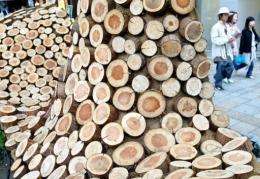In tree rings, Japanese scientists find 8th-century mystery

In the late eighth century, Earth was hit by a mystery blast of cosmic rays, according to a Japanese study that found a relic of the powerful event in cedar trees.
Analysis of two ancient trees found a surge in carbon-14 -- a carbon isotope that derives from cosmic radiation -- which occurred just in AD 774 and AD 775, the team report in the journal Nature on Sunday.
Earth is battered by protons and other sub-atomic particles which are blasted across space by high-energy sources.
The particles collide with the stratosphere and react with nitrogen to create carbon-14, which is then absorbed into the biosphere.
A team led by Fusa Miyake of Nagoya University found that levels of carbon-14 in the two cedars were about 1.2 percent higher in 774 and 775 compared to other years.
This may not sound much, but in relation to background concentrations of carbon-14, the difference is huge.
One source of cosmic rays is the Sun, whose activity varies in phases called Schwabe cycles. Our star also throws the occasional tantrum, spouting bursts of energy called solar flares.
But Miyake's team say that the cosmic whack of 774-775 cannot be attributed to the Schwabe cycle of the time -- and it is far bigger than any known flare from the Sun.
The other possibility is a supernova, or a star that explodes at the end of its life in a welter of gamma radiation.
It burns brightly for a few years before cooling into a remnant that can glow sullenly for centuries.
But there is no documented record in the northern hemisphere of a supernova at around 775.
Recent surveys of cosmic radiation show that, at this time, there were the remains of two nearby supernovae called Cassiopeia A and Vela Jr.
But they were probably too far away or not powerful enough to be responsible for the carbon-14 burst on Earth.
"With our present knowledge, we cannot specify the cause of this event," Miyake admits.
"However, we can say that an extremely energetic event occurred around our space environment in AD 775 ... (but) neither a solar flare nor a local supernova is likely to have been responsible."
The team are delving deeper into the mystery.
They intend to fine-tune the search for the source by looking at telltale traces of beryllium and nitrate isotopes.
They also plan a wider search of historical documents to see if, 1,237 years ago, anyone noted a strange flare in the sky.
More information: DOI: 10.1038/nature11123
Journal information: Nature
(c) 2012 AFP




















